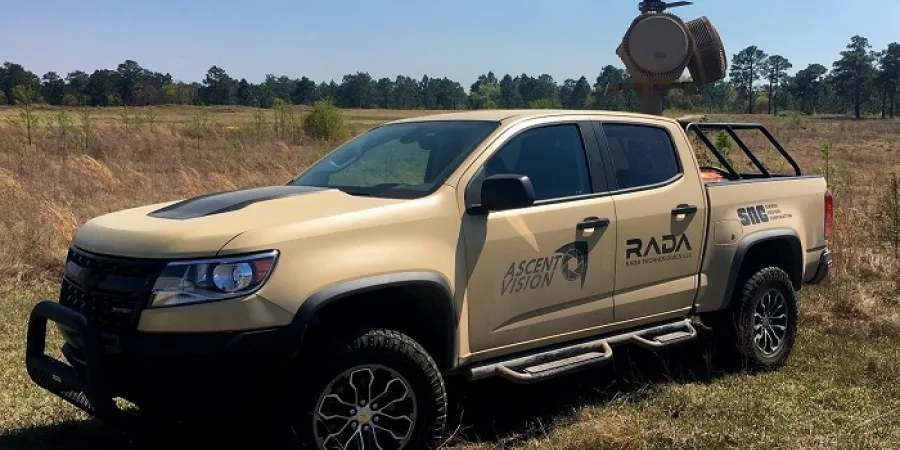RADA’s MHR Integrated in X-MADIS Counter-UAS System
The Multi-Mission Hemispheric Radar (MHR) is the primary detection and tracking sensor of X-MADIS, a counter-UAS solution jointly developed by RADA, Ascent Vision and Sierra Nevada which recently won a prize at SOFWERX ThunderDrone RPE III
Ami Rojkes Dombe
| 12/07/2018
Israeli company RADA Electronic Industries, together with its partners, Ascent Vision and Sierra Nevada Corporation, won a $200,000 prize at the SOFWERX ThunderDrone Rapid Prototyping Event (RPE) III demonstration, with its X-MADIS mobile drone defeat system.
RADA’s Multi-Mission Hemispheric Radar (MHR) is the primary detection and tracking sensor of X-MADIS (the eXpeditionary Mobile Aerial Defense Integrated System), tailored for Counter-unmanned aerial system (C-UAS) missions. Combined with other systems (Electro-Optical/Infrared and electronic warfare equipment), the system is integrated into a commercial off-road vehicle. It can detect, locate, identify, track, exploit and defeat an enemy UAS on the move or while in a stationary position, protecting airports, no-fly zones, and other high-value infrastructure.
Dov Sella, RADA’s CEO, commented, "We are very proud to be part of the industry team achieving this success for X-MADIS. The system is a derivate of a system deployed successfully with a Department of Defense customer. Therefore, it demonstrates that our technology is highly scalable, flexible and truly adaptable for multi-mission environments.”
The SOFWERX RPE demonstration events, also called Game of Drones, began in June 2017. More than 450 technological capabilities aimed to tackle sea, land, and air-based UAS, tactical swarms, payloads (kinetic/non-kinetic/sensors), and their associated data science applications. ThunderDrone RPE III was the culmination of the events and provided a venue for systems of various technologies to be tested in a true field environment.
SOFWERX is a Partnership Intermediary Agreement between Doolittle Institute and the United States Special Operations Command (USSOCOM), created to investigate new technology in an effort to put the most advanced capabilities into our warfighters’ hands.
The Multi-Mission Hemispheric Radar (MHR) is the primary detection and tracking sensor of X-MADIS, a counter-UAS solution jointly developed by RADA, Ascent Vision and Sierra Nevada which recently won a prize at SOFWERX ThunderDrone RPE III
Israeli company RADA Electronic Industries, together with its partners, Ascent Vision and Sierra Nevada Corporation, won a $200,000 prize at the SOFWERX ThunderDrone Rapid Prototyping Event (RPE) III demonstration, with its X-MADIS mobile drone defeat system.
RADA’s Multi-Mission Hemispheric Radar (MHR) is the primary detection and tracking sensor of X-MADIS (the eXpeditionary Mobile Aerial Defense Integrated System), tailored for Counter-unmanned aerial system (C-UAS) missions. Combined with other systems (Electro-Optical/Infrared and electronic warfare equipment), the system is integrated into a commercial off-road vehicle. It can detect, locate, identify, track, exploit and defeat an enemy UAS on the move or while in a stationary position, protecting airports, no-fly zones, and other high-value infrastructure.
Dov Sella, RADA’s CEO, commented, "We are very proud to be part of the industry team achieving this success for X-MADIS. The system is a derivate of a system deployed successfully with a Department of Defense customer. Therefore, it demonstrates that our technology is highly scalable, flexible and truly adaptable for multi-mission environments.”
The SOFWERX RPE demonstration events, also called Game of Drones, began in June 2017. More than 450 technological capabilities aimed to tackle sea, land, and air-based UAS, tactical swarms, payloads (kinetic/non-kinetic/sensors), and their associated data science applications. ThunderDrone RPE III was the culmination of the events and provided a venue for systems of various technologies to be tested in a true field environment.
SOFWERX is a Partnership Intermediary Agreement between Doolittle Institute and the United States Special Operations Command (USSOCOM), created to investigate new technology in an effort to put the most advanced capabilities into our warfighters’ hands.



